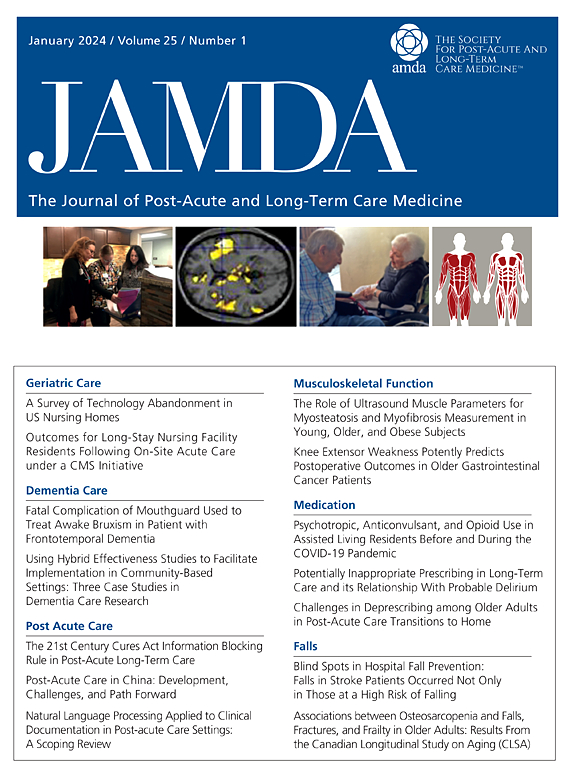Prolonged Use of Antidepressants Among Older People Residing in Long-Term Care Facilities
IF 4.2
2区 医学
Q2 GERIATRICS & GERONTOLOGY
Journal of the American Medical Directors Association
Pub Date : 2025-02-13
DOI:10.1016/j.jamda.2024.105482
引用次数: 0
Abstract
Objectives
Antidepressants are commonly used by older people and use increases during transition to long-term care facilities (LTCFs); however, little is known regarding duration of use following LTCF entry. This study aimed to examine duration of antidepressant use among new and existing antidepressant users after LTCF entry.
Design
Retrospective cohort study.
Setting and Participants
Non-Indigenous individuals aged 65 to 105 years who entered LTCFs in 2 Australian states between 2015 and 2018 and received an antidepressant between LTCF entry and ≤60 days after, were included.
Methods
Cumulative incidence function and Fine-Gray regression models adjusted for age, sex, and LTCF entry year, accounted for the competing risk of death, and estimated the subdistribution hazard ratio (sHR) and 95% confidence interval (95% CI) for antidepressant discontinuation for all, new, and existing users.
Results
Overall, 28,426 individuals entering 1035 LTCFs were included, of whom 22,365 (78.7%) were existing antidepressant users and 6061 (21.3%) were new users. Selective serotonin reuptake inhibitors and mirtazapine were commonly utilized. Overall, 36.1% (95% CI 35.1–37.1) of residents discontinued antidepressants (median follow-up 614 days, interquartile range 338–1002) following entry and 50.3% (95% CI 49.4–51.2) were dispensed enough to last until death. New antidepressant users had a 36% (adjusted sHR, 1.36; 95% CI, 1.29–1.44) higher risk of discontinuation compared with existing users.
Conclusions and Implications
Prolonged antidepressant use is common in LTCFs, and therapy is often continued until the end-of-life. Initiating nonpharmacological alternatives, regular review of antidepressant appropriateness, and seeking discontinuation opportunities where appropriate can minimize potentially inappropriate antidepressant use and risk of harm.
求助全文
约1分钟内获得全文
求助全文
来源期刊
CiteScore
11.10
自引率
6.60%
发文量
472
审稿时长
44 days
期刊介绍:
JAMDA, the official journal of AMDA - The Society for Post-Acute and Long-Term Care Medicine, is a leading peer-reviewed publication that offers practical information and research geared towards healthcare professionals in the post-acute and long-term care fields. It is also a valuable resource for policy-makers, organizational leaders, educators, and advocates.
The journal provides essential information for various healthcare professionals such as medical directors, attending physicians, nurses, consultant pharmacists, geriatric psychiatrists, nurse practitioners, physician assistants, physical and occupational therapists, social workers, and others involved in providing, overseeing, and promoting quality

 求助内容:
求助内容: 应助结果提醒方式:
应助结果提醒方式:


